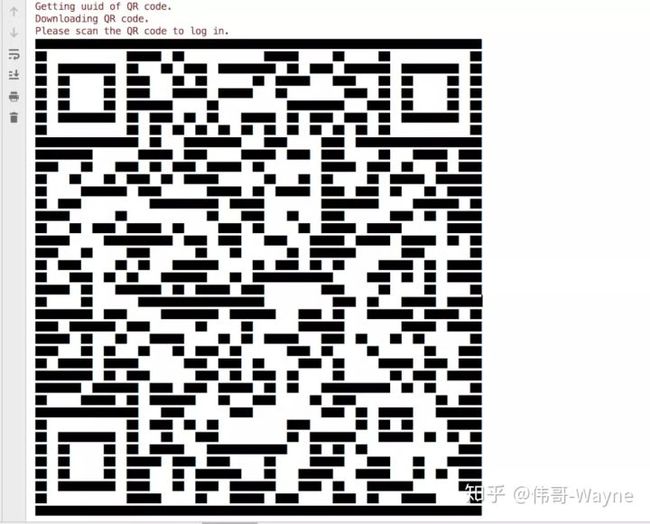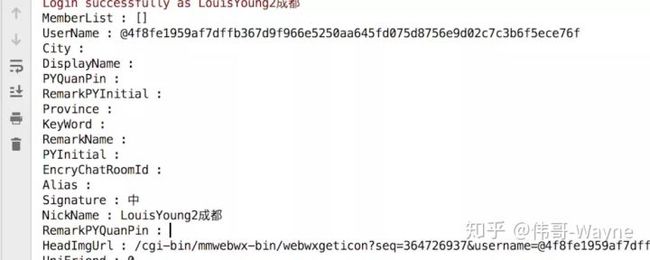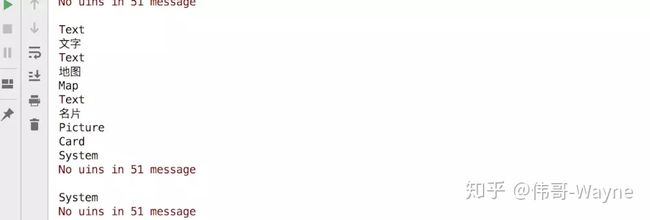神秘微信短信发送技术准备
在 Python语言中,有一个微信接口模块itchat,可以用来实现微信的一些功能,本主题专门使用itchat来实现一些应用:
- 掌握iChat的API结构;
- 应用iChat的API实现用户需求;
前提:安装iChat模块
> pip install itchat
安装过程截图:
Python3.6版本下,itchat模块安装过程
一、itchat的API结构
使用dir函数可以获取itchat中的API信息;
代码:
import itchat
print(dir(itchat))
上述代码在python交互编程模式下,与ipython中都可以使用。
获取的API信息如下(从ipython中拷贝的):
['Core', 'VERSION', '__builtins__', '__cached__', '__doc__', '__file__', '__loader__', '__name__', '__package__', '__path__', '__spec__', '__version__', 'add_friend', 'add_member_into_chatroom', 'auto_login', 'check_login', 'components', 'config', 'configured_reply', 'content', 'core', 'create_chatroom', 'delete_member_from_chatroom', 'dump_login_status', 'get_QR', 'get_QRuuid', 'get_chatrooms', 'get_contact', 'get_friends', 'get_head_img', 'get_mps', 'get_msg', 'instanceList', 'load_login_status', 'log', 'login', 'logout', 'msg_register', 'new_instance', 'originInstance', 'returnvalues', 'revoke', 'run', 'search_chatrooms', 'search_friends', 'search_mps', 'send', 'send_file', 'send_image', 'send_msg', 'send_raw_msg', 'send_video', 'set_alias', 'set_chatroom_name', 'set_logging', 'set_pinned', 'show_mobile_login', 'start_receiving', 'storage', 'update_chatroom', 'update_friend', 'upload_file', 'utils', 'web_init']
根据字面意思,大致也知道上述函数的作用,具体的使用可以使用help函数获取。代码如下:
help(itchat.login)
或者
help('itchat.login')
获取的帮助结果如下:
Help on method login in module itchat.components.login:
login(enableCmdQR=False, picDir=None, qrCallback=None, loginCallback=None, exitCallback=None) method of itchat.core.Core instance
帮助输出截图
二、itchat的使用
1. 登录/登出
(1)登录函数
def login(self, enableCmdQR=False, picDir=None, qrCallback=None, loginCallback =None, exitCallback=None):
log in like web wechat does
for log in
- a QR code will be downloaded and opened
- then scanning status is logged, it paused for you confirm
- finally it logged in and show your nickName
for options
- enableCmdQR: show qrcode in command line
- integers can be used to fit strange char length
- picDir: place for storing qrcode
- qrCallback: method that should accept uuid, status, qrcode
- loginCallback: callback after successfully logged in
- if not set, screen is cleared and qrcode is deleted
- exitCallback: callback after logged out
- it contains calling of logout
for usage
..code::python
import itchat
itchat.login()
it is defined in components/login.py
and of course every single move in login can be called outside
you may scan source code to see how
- and modified according to your own demand
使用代码
#coding=utf-8
import itchat
itchat.login()
login函数执行过程中会产生一个二维码图片,more存放在login运行的当前工作目录,并且使用工具打开。
login登录运行过程
在用户使用手机扫描登录前,login处于阻塞状态;等扫描登录完成,会提示登录成功。登录成功后的输出:
登录成功后的输出截图
通过设置qrCallback与loginCallback可以控制登录过程,比如使用定制二维码显示,以及登录成功后的一些定制处理。qrCallback回调在长时间没有登录的情况,会被反复调用。
同时还可以使用命令行显示二维码,命令行模式下qrCallback参数设置后无效,在命令行(或者控制台)显示二维码注意:enableCmdQR参数可以设置为True或者False,也可以是整数,整数也是True,但可以指定二维码显示的宽度,某些平台下控制台一个字符占用2个字符,可以设置为2,这样二维码显示才会正常,否则显示不是太正常。
代码:
#命令行模式
itchat.login(enableCmdQR=2,loginCallback=login_cb)
效果:
命令行二维码
可以将enableCmdQR赋值为负值改变命令行二维码的背景与前景色。
还有一个auto_login函数也可以实现自动登录,该函数的声明如下:马哥教育官网-专业Linux云计算培训、Python人工智能培训机构
auto_login(hotReload=False, statusStorageDir='itchat.pkl', enableCmdQR=False, picDir=None, qrCallback=None, loginCallback=None, exitCallback=None)
第一个参数是掉线后,短时间内登录,不扫描二维码。
(2)登出函数
def logout(self):
''' logout
if core is now alive
logout will tell wechat backstage to logout
and core gets ready for another login
it is defined in components/login.py
'''
raise NotImplementedError()
(3)登录状态检测
def check_login(self, uuid=None):
''' check login status
for options:
- uuid: if uuid is not set, latest uuid you fetched will be used
for return values:
- a string will be returned
- for meaning of return values
- 200: log in successfully
- 201: waiting for press confirm
- 408: uuid timed out
- 0 : unknown error
for processing:
- syncUrl and fileUrl is set
- BaseRequest is set
blocks until reaches any of above status
it is defined in components/login.py
'''
如果uuid参数为None,默认是最后一次登录的uuid。
2. 信息获取
与操作文件系统一样,登录后,就是微信信息获取,主要是好友信息,群信息,公众号信息等。
好友、群聊、公众号信息提供常见的操作函数:
#函数类型说明1 get_XXX 获取2 update_XXX 更新3 search_XXX 搜索4 add_XXX 添加5 delete_XXX 删除6 set_XXX 修改
下面我们仅仅列出get_XXXX相关的函数声明。
(1)get_contact获取群聊信息
get_contact与get_chatrooms作用一样。
def get_contact(self, update=False):
''' fetch part of contact
for part
- all the massive platforms and friends are fetched
- if update, only starred chatrooms are fetched
for options
- update: if not set, local value will be returned
for results
- chatroomList will be returned
it is defined in components/contact.py
'''
raise NotImplementedError()
(2)get_friends获取好友
def get_friends(self, update=False):
''' fetch friends list
for options
- update: if not set, local value will be returned
for results
- a list of friends' info dicts will be returned
it is defined in components/contact.py
'''
raise NotImplementedError()
(3)get_chatrooms获取群聊
def get_chatrooms(self, update=False, contactOnly=False):
''' fetch chatrooms list
for options
- update: if not set, local value will be returned
- contactOnly: if set, only starred chatrooms will be returned
for results
- a list of chatrooms' info dicts will be returned
it is defined in components/contact.py
'''
raise NotImplementedError()
(4)get_mps获取公众号
def get_mps(self, update=False):
''' fetch massive platforms list
for options
- update: if not set, local value will be returned
for results
- a list of platforms' info dicts will be returned
it is defined in components/contact.py
'''
raise NotImplementedError()
(5)获取好友,群聊、公众号的例子
#coding=utf-8
import itchat
from itchat.storage.templates import ContactList
itchat.auto_login()
print(itchat.get_contact())
print(itchat.get_chatrooms())
print(itchat.get_friends())
print(itchat.get_mps())
print(type(itchat.get_contact()))
print(type(itchat.get_chatrooms()))
print(type(itchat.get_friends()))
print(type(itchat.get_mps()))
获取的好友、群聊、公众号信息如下:
获取的信息输出
获取的信息返回的都是列表,列表的类型如下:
(6)ContactList类型定义
class ContactList(list):
''' when a dict is append, init function will be called to format that dict '''
def __init__(self, *args, **kwargs):
super(ContactList, self).__init__(*args, **kwargs)
self.__setstate__(None)
@property
def core(self):
return getattr(self, '_core', lambda: fakeItchat)() or fakeItchat
@core.setter
def core(self, value):
self._core = ref(value)
def set_default_value(self, initFunction=None, contactClass=None):
if hasattr(initFunction, '__call__'):
self.contactInitFn = initFunction
if hasattr(contactClass, '__call__'):
self.contactClass = contactClass
def append(self, value):
contact = self.contactClass(value)
contact.core = self.core
if self.contactInitFn is not None:
contact = self.contactInitFn(self, contact) or contact
super(ContactList, self).append(contact)
def __deepcopy__(self, memo):
r = self.__class__([copy.deepcopy(v) for v in self])
r.contactInitFn = self.contactInitFn
r.contactClass = self.contactClass
r.core = self.core
return r
def __getstate__(self):
return 1
def __setstate__(self, state):
self.contactInitFn = None
self.contactClass = User
def __str__(self):
return '[%s]' % ', '.join([repr(v) for v in self])
def __repr__(self):
return '<%s: %s>' % (self.__class__.__name__.split('.')[-1],
self.__str__())
ContactList继承是是内置列表类型list。
3. 好友、群聊、公众号信息处理
(1)好友、群聊、公众号信息结构定义
实际上上面代码返回的列表中元素类型是不同的,下面可以使用代码输出:
#coding=utf-8
import itchat
from itchat.storage.templates import ContactList
itchat.auto_login()
list_contact=itchat.get_contact()
list_chatrooms=itchat.get_chatrooms()
list_friends=itchat.get_friends()
list_mps=itchat.get_mps()
print(type( list_contact[0]))
print(type( list_chatrooms[0]))
print(type( list_friends[0]))
print(type( list_mps[0]))
列表中类型分别是:
(2)Chatroom信息结构
Chatroom最上层父类是dict类型,继承结构:
class Chatroom(AbstractUserDict)
class AbstractUserDict(AttributeDict)
class AttributeDict(dict)
根据字典的特点,信息的索引主要靠key,获取其key如下:
import itchat
from itchat.storage.templates import Chatroom
from itchat.storage.templates import User
from itchat.storage.templates import MassivePlatform
itchat.auto_login()
list_contact=itchat.get_contact()
list_chatrooms=itchat.get_chatrooms()
list_friends=itchat.get_friends()
list_mps=itchat.get_mps()
print(list_contact[0].keys())
print(list_chatrooms[0].keys())
print(list_friends[0].keys())
print(list_mps[0].keys())
字典keys如下:
dict_keys(['MemberList', 'Uin', 'UserName', 'NickName', 'HeadImgUrl', 'ContactFlag', 'MemberCount', 'RemarkName', 'HideInputBarFlag', 'Sex', 'Signature', 'VerifyFlag', 'OwnerUin', 'PYInitial', 'PYQuanPin', 'RemarkPYInitial', 'RemarkPYQuanPin', 'StarFriend', 'AppAccountFlag', 'Statues', 'AttrStatus', 'Province', 'City', 'Alias', 'SnsFlag', 'UniFriend', 'DisplayName', 'ChatRoomId', 'KeyWord', 'EncryChatRoomId', 'IsOwner', 'IsAdmin', 'Self'])
(3)User信息结构
User与Chatroom基本上一样。
class User(AbstractUserDict)
class AbstractUserDict(AttributeDict)
class AttributeDict(dict)
User是字典key如下:
dict_keys(['MemberList', 'UserName', 'City', 'DisplayName', 'PYQuanPin', 'RemarkPYInitial', 'Province', 'KeyWord', 'RemarkName', 'PYInitial', 'EncryChatRoomId', 'Alias', 'Signature', 'NickName', 'RemarkPYQuanPin', 'HeadImgUrl', 'UniFriend', 'Sex', 'AppAccountFlag', 'VerifyFlag', 'ChatRoomId', 'HideInputBarFlag', 'AttrStatus', 'SnsFlag', 'MemberCount', 'OwnerUin', 'ContactFlag', 'Uin', 'StarFriend', 'Statues', 'WebWxPluginSwitch', 'HeadImgFlag'])
(4)MassivePlatform信息结构
MassivePlatform与Chatroom基本上一样。
class MassivePlatform(AbstractUserDict)
class AbstractUserDict(AttributeDict)
class AttributeDict(dict)
MassivePlatform是字典key如下:
dict_keys(['MemberList', 'Uin', 'UserName', 'NickName', 'HeadImgUrl', 'ContactFlag', 'MemberCount', 'RemarkName', 'HideInputBarFlag', 'Sex', 'Signature', 'VerifyFlag', 'OwnerUin', 'PYInitial', 'PYQuanPin', 'RemarkPYInitial', 'RemarkPYQuanPin', 'StarFriend', 'AppAccountFlag', 'Statues', 'AttrStatus', 'Province', 'City', 'Alias', 'SnsFlag', 'UniFriend', 'DisplayName', 'ChatRoomId', 'KeyWord', 'EncryChatRoomId', 'IsOwner'])
下面是用户信息的获取:
#coding=utf-8
import itchat
itchat.auto_login()
list_friends=itchat.get_friends()
one_user=list_friends[0]
for key in one_user:
print(key,":",one_user[key])
下面是获取的的部分用户信息:
微信用户本人信息
4. 用户信息接收
接收消息采用的是类似事件处理的注册方式,一单某个函数注册以后(注册时函数需要与某个消息类型关联),当接收到相应类型的消息,该函数就调用。
(1)消息注册的方式
消息的注册,使用的是python的装饰器技术,装饰器的定义如下:
def msg_register(self, msgType, isFriendChat=False, isGroupChat=False, isMpChat=False):
参数说明:
msgType: 指定该方法用于处理的消息类型
isFriendChar: 处理好友消息
isGroupChat: 处理群消息
isMpChat: 处理公众号消息
(2)消息的类型
其中msgType的值支持如下集中:
消息类型类型说明TEXT 文本PICTURE 图片FRIENDS 好友CARD 名片MAP 位置SHARING 共享RECORDING 语音=VOICEATTACHMENT 附件VIDEO 视频VIOCE 音频= RECORDINGNOTE 消息撤回SYSTEM 系统
上述消息类型的定义如下:
TEXT = 'Text'
MAP = 'Map'
CARD = 'Card'
NOTE = 'Note'
SHARING = 'Sharing'
PICTURE = 'Picture'
RECORDING = VOICE = 'Recording'
ATTACHMENT = 'Attachment'
VIDEO = 'Video'
FRIENDS = 'Friends'
SYSTEM = 'System'
提示:在itchat的安装库文件content.py中定义。使用的时候,需要import itchat.content,省事的import方式:
from itchat.content import *
下面是一段接收所有类型的信息的代码:
#coding=utf-8
import itchat
from itchat.content import *
@itchat.msg_register(msgType=INCOME_MSG,isFriendChat=True,isGroupChat=True,isMpChat=True)
def recv_msg(msg):
print(msg);
#登录
itchat.auto_login()
#运行
itchat.run(debug=True)
#退出登录
itchat.logout()
获得消息显示如下:
获取没有经过分析的聊天信息
5. 用户信息类型与处理
通过注册消息处理函数,实现异步回调的方式来接收聊天信息,传递过来的消息类型是:
class 'itchat.storage.messagequeue.Message'
Message类与上面User本质也是一个字典类型,继承结构如下:
Message-> AttributeDict-> dict
class Message(AttributeDict):
class AttributeDict(dict):
不同类型的信息,其字典keys是不同的,就是内容有差别:
dict_keys(['MsgId', 'FromUserName', 'ToUserName', 'MsgType', 'Content', 'Status', 'ImgStatus', 'CreateTime', 'VoiceLength', 'PlayLength', 'FileName', 'FileSize', 'MediaId', 'Url', 'AppMsgType', 'StatusNotifyCode', 'StatusNotifyUserName', 'RecommendInfo', 'ForwardFlag', 'AppInfo', 'HasProductId', 'Ticket', 'ImgHeight', 'ImgWidth', 'SubMsgType', 'NewMsgId', 'OriContent', 'EncryFileName', 'User', 'Type', 'Text', 'SystemInfo'])
dict_keys(['Type', 'Text', 'SystemInfo', 'FromUserName', 'ToUserName', 'User'])
下面是一个专门接收好友文本信息的代码:
#coding=utf-8
import itchat
from itchat.content import *
@itchat.msg_register(msgType=INCOME_MSG,isFriendChat=True,isGroupChat=False,isMpChat=False)
def recv_msg(msg):
print(msg['Type'])
if msg['Type'] == TEXT :
print(msg['Text'])
#登录
itchat.auto_login()
#运行
itchat.run(debug=True)
#退出登录
itchat.logout()
接收到信息如下:
简单的用户聊天信息接收,可以根据需要做更加复杂的处理
6. 用户信息发送
发送用户消息,有两种方式:
(1)原生消息发送
def send_raw_msg(self, msgType, content, toUserName):
''' many messages are sent in a common way
for demo
.. code:: python
@itchat.msg_register(itchat.content.CARD)
def reply(msg):
itchat.send_raw_msg(msg['MsgType'], msg['Content'], msg['FromUserName'])
there are some little tricks here, you may discover them yourself
but remember they are tricks
it is defined in components/messages.py
'''
def send(self, msg, toUserName=None, mediaId=None):
''' wrapped function for all the sending functions
for options
- msg: message starts with different string indicates different type
- list of type string: ['@fil@', '@img@', '@msg@', '@vid@']
- they are for file, image, plain text, video
- if none of them matches, it will be sent like plain text
- toUserName: 'UserName' key of friend dict
- mediaId: if set, uploading will not be repeated
it is defined in components/messages.py
'''
raise NotImplementedError()
(2)快捷发送函数
#发送文本
def send_msg(self, msg='Test Message', toUserName=None)
#发送文件
def send_file(self, fileDir, toUserName=None, mediaId=None)
#发送图像
def send_image(self, fileDir, toUserName=None, mediaId=None)
#发送视频
def send_video(self, fileDir=None, toUserName=None, mediaId=None):
下面简单的展示一个发动短信的例子(其他视频,语音基本上类似)。
#coding=utf-8
import itchat
import time
#登录
itchat.auto_login()
#根据昵称找用户
user=itchat.search_friends(nickName='赵德柱')[0]
#每隔5秒给用户发一个短信
for i in range(10):
itchat.send_msg(msg="辣鸡短信,不必理会!",toUserName=user['UserName'])
time.sleep(5)
#退出登录
itchat.logout()
上面代码可以改成个人好友信息测试。
来源:www.magedu.com








